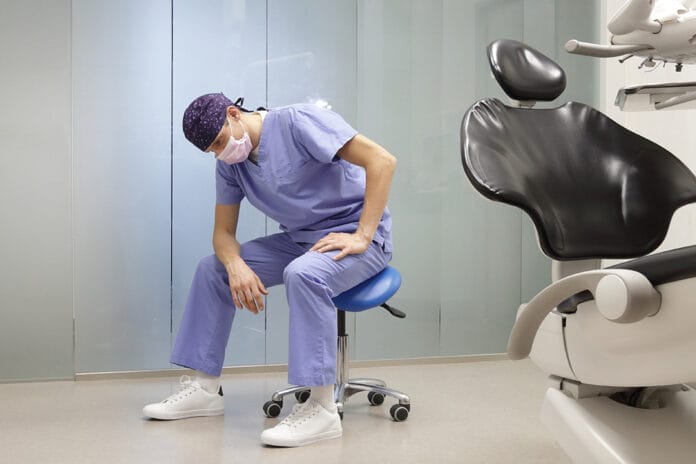Today was a tough day. We’ve all had challenging days – especially lately.
First, there was Joseph. He hadn’t been in for 18 months between working in Mumbai and the current pandemic of COVID-19. Joseph has been using a manual toothbrush and floss picks daily. He has also been under a great deal of stress having come back to town for a visit and then being stranded here because of travel restrictions due to the pandemic. In addition, he works for a major oil company that has been having massive layoffs. He says it’s difficult not knowing each day if you might be let go.
Joseph’s periodontal examination revealed generalized moderate inflammation, heavy calculus on the facial and lingual of the lower anterior teeth, and light calculus randomly along line angles and interproximally throughout his mouth. Joseph’s periodontal probe readings were generally 2-3mm with a couple of 4mm readings. The radiographs revealed no radiographic bone loss. (We know that there has to be significant bone loss to even register radiographically, so I use a combination of radiographs and probe readings to determine bone health.)
I prescribed gingivitis therapy, and Joseph agreed. As I performed the procedure, I also spent time educating Joseph on his oral condition and demonstrating proper self-care techniques and recommended stress reduction techniques because we know that stress impairs our immune function. Joseph was open to all suggestions. A very normal start to one’s day, right?
No Easy and Simple Prophys
The next three patients were brothers: Paul, 16, Daniel, 20, and James, 22. These young men all had mandibular and maxillary fixed retainers, all used manual toothbrushes, and none of them were flossing or doing any other type of interdental cleaning. Each of them had heavy deposits and generalized inflammation.
Paul admitted to not brushing his teeth daily with the justification that he was not attending school in person. He had severe inflammation with extremely easy bleeding on probing and heavy calculus deposits on the facial and lingual of the mandibular anterior teeth and the buccal aspect of the maxillary molars. He had light calculus along the entire lingual margin of the mandibular arch, as well.
Daniel and James had moderate inflammation with a similar distribution of hard deposits. None of the brothers had any bone loss. Again, the diagnosis for each was gingivitis: severe in Paul’s case and moderate in Daniel and James.
The treatment recommendations were the same ─ gingivitis therapy and very clear communication regarding their condition and how it was caused. The discussion included the potential consequences of not improving their oral health, the benefits of optimal oral health, the procedure details, and their responsibility as far as their self-care, including demonstrating self-care techniques, allowing them to practice those techniques, mentioning products to avoid, and options for interdental cleaning.
When scheduling people in that age range, I believe administrative team members would assume that they would receive a simple, easy prophylaxis. This is so often not the case. And all of that talking, along with all of that scaling, left me a bit fatigued. I feel very fortunate to have been allowed an hour per patient, which is actually non-negotiable for me. But these days, I suffer a great deal of pain when I treat patients (Young hygienists, take proper ergonomics seriously and protect yourselves!).
So I was ready to go home after these four patients. But it was only just after 11 a.m.!
A Fearful Story to Tell
After entering notes, cleaning, and resetting my room for my next patient ─ a new patient ─ five minutes were left of my 30-minute break. So, I did what we do. I went to the restroom, then took a big gulp of water, swallowed an ibuprofen to ease my ever-present back pain, and I called my next patient back.
And that’s when my day turned around.
My new patient, Mary Ann, had a story to tell, and I could see in her eyes that she needed to be heard. Before I reviewed her health history, before I exposed any radiographs, and before I looked in her mouth, I sat down facing her and said, “I’d like to hear your story so I can help you the best way I know how.” And then I listened.
Mary Ann is 45 years old, the youngest of 12 children from a humble family. She grew up with little preventive care, inadequate self-care habits, and a diet heavy in carbohydrates. By the time she was 16, she had experienced decay in every tooth and had undergone many dental treatments done by various dentists.
Some of the doctors were kind, and others were not. She shared that one was particularly cruel. My suspicions were confirmed that this was a patient who lacked trust and who needed reassurance that she would be heard, and her thoughts, concerns, and needs would be important to us. Mary Ann was understandably anxious about meeting yet another dentist. She had come to us on a personal referral. So, she was hopeful but still nervous.
Mary Ann confessed that, while her oral health was important to her, she had spent the last several years caring for everyone else: her four children who had just been uprooted and moved to a new city, her suddenly unemployed husband, her ailing mother, and her stepfather who was suffering from dementia. She had put her own health needs on the back burner, but she was happy to say that her mother is now in more stable health, her children have adjusted to their recent move, and her husband has found new employment. She is finally ready to take care of herself.
Mary Ann told me that she saw a different dentist in the area initially and was given a $15,000 treatment plan with no concession for interim care or phasing of the treatment so she could manage it financially. She felt overwhelmed at the idea of spending so much money that she doesn’t have and being told there were no options to do it any other way but all at once.
Mary Ann told me that she went to an appointment at the other office expecting to have some cavities treated but was told she would be having a “cleaning” that day. When she checked out at the front that day, she saw her “cleaning” cost $1,000. She assumed it must have been a “deep cleaning” but had not been told anything other than a “cleaning.”
Mary Ann shared that she had been told in the past that her “readings” were 1s, 2s, and 3s, and that those were good readings. She had not been told what her readings were when they were taken at this practice and was surprised that she needed anything other than a “regular cleaning.” Mary Ann told me she didn’t know what they really did or why they charged so much. That’s when she sought out another practice, and I’m so happy she found us.
Putting Mary Ann at Ease
Communication with patients is so critical. We must make sure our patients understand their condition and our prescribed treatment as well as their responsibilities as far as the fees and their self-care.
By the time I asked permission to review her health history and take vital signs, Mary Ann was noticeably more relaxed, having been allowed to fully share her story and her concerns. I discovered in our conversation that she had recently been diagnosed with an autoimmune disease, Sjogren’s syndrome, which she had failed to note on her health history. We know that Sjogren’s syndrome can cause mucosal tissue dryness, which increases the risk of dental caries.
This is why we must take the time to talk with our patients about their health and to ask pertinent questions. We must sleuth out information that they forget to share or that they don’t believe would have any impact on their oral health.
Mary Ann agreed to let me expose a complete series of radiographs and do an initial examination. I found she had rampant active decay, including six composites with recurrent caries, 13 root canals that had unhealed apical lesions, 11 crowns that had recurrent caries, #18 and #19 were nonrestorable, and she had recently lost #30 to a root fracture. In addition, her bite is off balance, and she has TMJ pain.
I stopped midway through my examination to give her a warm compress to ease her TMJ pain enough to finish my exam. She exclaimed that no one had ever acknowledged that her joint pain was real, much less been so kind as to offer her a compress. I explained that her joint pain could be addressed in the short term with laser treatment and in the long term with the doctor’s comprehensive plan. She was so happy with that simple news.
Too many health-care practitioners fail to address the patient’s concerns! We tend to focus on those things we feel are most important.
Benefits of Special Attention
At this point, I messaged the office manager to let her know I was running behind and that I needed more time with this patient. It was clear that Mary Ann needed extra care and needed not to be rushed. Karla was able to shift one of my patients to another hygienist on the team and to have another of my patients come a bit later than planned.
We had scheduled 90 minutes for the new patient appointment. Ultimately, I spent two and a half hours with Mary Ann. When your gut tells you that your patient needs special attention, and you get flexible and do whatever it takes, it usually pays off in exceeding that patient’s expectations. That typically results in a loyal patient for life, someone who will refer family and friends and who will accept treatment recommendations. It’s a win for the patient and the practice.
The periodontal examination revealed moderate generalized gingivitis, with bone loss only in the area of the extracted tooth. Otherwise, her readings were 2, 3, and 4mm. She had interproximal and subgingival deposits and generalized inflammation, but I expected a much more involved periodontal condition. I gave her the good news that we can help her regain her periodontal health with gingivitis therapy and by tweaking her self-care routine.
I explained the serious systemic consequences of not treating gingivitis and the importance of dedicating herself to her daily self-care. Mary Ann said she was on board to do whatever it takes to get healthy. She seemed very relieved that there was some positive news. Dr. Melissa came in and performed her initial examination with Mary Ann. There are many treatment options to discuss and consider, so plans were made for a separate consultation during which Mary Ann and the doctor will devise a comprehensive plan. They will prioritize treatment into phases that Mary Ann will be comfortable managing both emotionally and financially.
After the examination was complete, we made plans for Mary Ann to return for gingivitis therapy. We discussed products for her caries control and those to help combat her dry mouth, which we believe is contributing to her caries. We also reviewed self-care techniques and products to help balance her oral biofilm and improve her gingival health.
Mary Ann told me she has never been happier at a dental office and that she can’t believe she feels so safe with us and confident that our recommendations are solely based on what is in her best interest. She confided that she has always felt a bit suspicious of dental recommendations because no one has ever fully explained all of the pros and cons to her and included her in the decision-making process.
Mary Ann said she feels empowered to take charge of her health with our help and that she can’t wait to get started. If it weren’t for COVID-19 restrictions regarding social distancing and avoiding physical contact, I know we would have shared a big hug at the end of that appointment.
I went into the new patient appointment tired and in pain but instantly turned off any thoughts of myself and focused fully on the person in front of me. This is what I coach my client teams to do. Imagine you’re about to step onto a stage, and it’s showtime. Ask yourself who do you need to be for your patient? At that moment with Mary Ann, I needed to be an empathetic caregiver. And that’s the gift I gave her.
That was also a gift I gave myself. I felt so energized and fulfilled after that appointment with Mary Ann. This is what I love to do. I love to listen and empathize and make people feel heard and respected as individuals who have a story to tell. I love to gently guide people to the path that will help them to restored health. And I love to support them all along that path.
Sometimes it’s a rocky road, sometimes they stall out, and I have to wait with them until they are ready and able to move forward again. Whatever their path is, I’m here to walk it with them. This is how I love my patients back to health. And this is how I fall in love with my career all over again.












